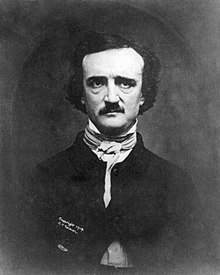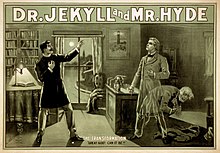By the Victorian era, Gothic had ceased to be the dominant genre, and was dismissed by most critics. (Indeed, the form's popularity as an established genre had already begun to erode with the success of the historical romance popularized by Sir Walter Scott.) However, in many ways, it was now entering its most creative phase. Recently readers and critics have begun to reconsider a number of previously overlooked Penny Blood or "penny dreadful" serial fictions by such authors as G.W.M. Reynolds who wrote a trilogy of Gothic horror novels: Faust(1846), Wagner the Wehr-wolf (1847) and The Necromancer (1857). Reynolds was also responsible for The Mysteries of London which has been accorded an important place in the development of the urban as a particularly Victorian Gothic setting, an area within which interesting links can be made with established readings of the work of Dickens and others. Another famous penny dreadful of this era was the anonymously authored Varney the Vampire (1847). Varney is the tale of the vampire Sir Francis Varney, and introduced many of the tropes present in vampire fiction recognizable to modern audiences — it was the first story to refer to sharpened teeth for a vampire.The formal relationship between these fictions, serialised for predominantly working class audiences, and the roughly contemporaneous sensation fictions serialised in middle class periodicals is also an area worthy of inquiry.
An important and innovative reinterpreter of the Gothic in this period was Edgar Allan Poe. Poe focused less on the traditional elements of gothic stories and more on the psychology of his characters as they often descended into madness. Poe's critics complained about his "German" tales, to which he replied, 'that terror is not of Germany, but of the soul'. Poe, a critic himself, believed that terror was a legitimate literary subject. His story "The Fall of the House of Usher" (1839) explores these 'terrors of the soul' while revisiting classic Gothic tropes of aristocratic decay, death, and madness.[42] The legendary villainy of the Spanish Inquisition, previously explored by Gothicists Radcliffe, Lewis, and Maturin, is based on a true account of a survivor in "The Pit and the Pendulum" (1842). The influence of Ann Radcliffe is also detectable in Poe's "The Oval Portrait" (1842), including an honorary mention of her name in the text of the story.
The influence of Byronic Romanticism evident in Poe is also apparent in the work of the Brontë sisters. Emily Brontë's Wuthering Heights(1847) transports the Gothic to the forbidding Yorkshire Moors and features ghostly apparitions and a Byronic hero in the person of the demonic Heathcliff. The Brontës' fiction is seen by some feminist critics as prime examples of Female Gothic, exploring woman's entrapment within domestic space and subjection to patriarchal authority and the transgressive and dangerous attempts to subvert and escape such restriction. Emily's Cathy and Charlotte Brontë's Jane Eyre are both examples of female protagonists in such a role. Louisa May Alcott's Gothic potboiler, A Long Fatal Love Chase (written in 1866, but published in 1995) is also an interesting specimen of this subgenre.
Elizabeth Gaskell's tales "The Doom of the Griffiths" (1858) "Lois the Witch", and "The Grey Woman" all employ one of the most common themes of Gothic fiction, the power of ancestral sins to curse future generations, or the fear that they will.
The gloomy villain, forbidding mansion, and persecuted heroine of Sheridan Le Fanu's Uncle Silas (1864) shows the direct influence of both Walpole's Otranto and Radcliffe's Udolpho. Le Fanu's short story collection In a Glass Darkly (1872) includes the superlative vampire tale Carmilla, which provided fresh blood for that particular strand of the Gothic and influenced Bram Stoker's vampire novel Dracula (1897). According to literary critic Terry Eagleton, Le Fanu, together with his predecessor Maturin and his successor Stoker, form a subgenre of Irish Gothic, whose stories, featuring castles set in a barren landscape, with a cast of remote aristocrats dominating an atavistic peasantry, represent in allegorical form the political plight of colonial Ireland subjected to the Protestant Ascendancy.
The genre was also a heavy influence on more mainstream writers, such as Charles Dickens, who read Gothic novels as a teenager and incorporated their gloomy atmosphere and melodrama into his own works, shifting them to a more modern period and an urban setting, including Oliver Twist (1837–8), Bleak House (1854) (Mighall 2003) and Great Expectations (1860–61). These pointed to the juxtaposition of wealthy, ordered and affluent civilisation next to the disorder and barbarity of the poor within the same metropolis. Bleak House in particular is credited with seeing the introduction of urban fog to the novel, which would become a frequent characteristic of urban Gothic literature and film (Mighall 2007). His most explicitly Gothic work is his last novel, The Mystery of Edwin Drood, which he did not live to complete and which was published in unfinished state upon his death in 1870. The mood and themes of the Gothic novel held a particular fascination for the Victorians, with their morbid obsession with mourning rituals, mementos, and mortality in general.
The 1880s saw the revival of the Gothic as a powerful literary form allied to fin de siecle, which fictionalized contemporary fears like ethical degeneration and questioned the social structures of the time. Classic works of this Urban Gothicinclude Robert Louis Stevenson's Strange Case of Dr Jekyll and Mr Hyde (1886), Oscar Wilde's The Picture of Dorian Gray (1891), George du Maurier's Trilby (1894), Richard Marsh's The Beetle: A Mystery (1897), Henry James' The Turn of the Screw (1898), and the stories of Arthur Machen. Some of the works of Canadian writer Gilbert Parker also fall into the genre, including the stories in The Lane that Had No Turning (1900).
The most famous Gothic villain ever, Count Dracula, was created by Bram Stoker in his novel Dracula (1897). Stoker's book also established Transylvania and Eastern Europe as the locus classicus of the Gothic. Gaston Leroux's serialized novel The Phantom of the Opera(1909–1910) is another well-known example of gothic fiction from the early 20th century.
In America, two notable writers of the end of the 19th century, in the Gothic tradition, were Ambrose Bierce and Robert W. Chambers. Bierce's short stories were in the horrific and pessimistic tradition of Poe. Chambers, though, indulged in the decadent style of Wilde and Machen, even to the extent of his inclusion of a character named 'Wilde' in his The King in Yellow






No comments:
Post a Comment